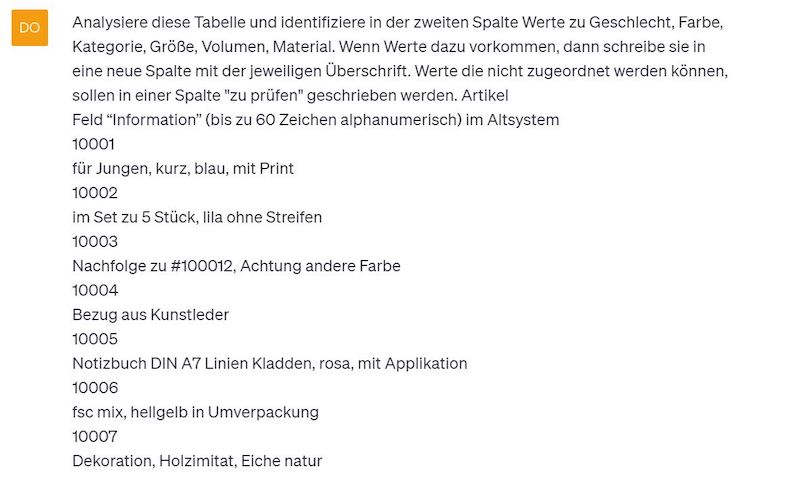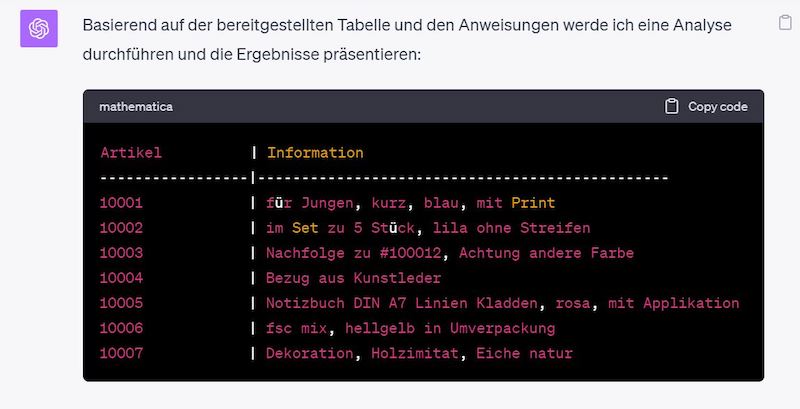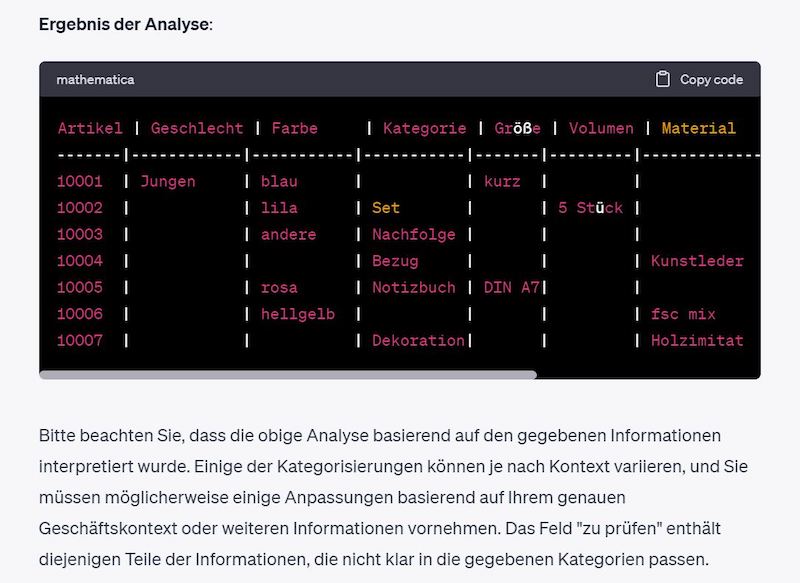What the Future Brings - AI and ERP Systems in Retail
We show you which AI tools can spare you manual data maintenance and facilitate your online trading.

AI has increasingly found its way into customer-relevant applications in recent years. Intelligent price management, individualized approach with offers and services or customer communication via ChatBot. Essentially, these are large computational models that calculate certain probabilities based on parameters and then "act" or produce results.
What AI solutions are already being used in online retail?
The use of AI in customer interaction always has the goal of reacting even faster, even more efficiently, and even more precisely to individual customers or automate corresponding processes in the company. A recent example is certainly the "Sidekick" from Shopify, an AI tool integrated into the shop software, which is supposed to significantly simplify the working processes "onsite". Thus, the tool can very independently carry out a sorting & ranking of the products listed in the online shop according to profitability criteria, or entire ranges can be deactivated and recreated at the change of seasons. This saves time and nerves.
The shop provider Shopware also integrates the AI Copilot", AI applications directly into the software, enabling efficient onsite management through, for example, AI content creation or AI translations, and much more.
There are already numerous examples today for AI solutionsin the "frontend"," i.e., in systems/tools that are intended for interaction with customers. But retail is much more: goods have to be purchased, item master data has to be created and maintained,, vendor master data has to be maintained, bookings, goods movements or discounts have to be made. Of course, the goods also have to be packed and shipped and a return has to be processed and cleared. These aspects of the "backend" in (digital) retail are still relatively AI-poor. Here, a lot of work is done manually and not always efficiently. This is due to the fact that work is more complex in the sense of involved departments, partner companies, and involved systems. We are talking about many individual processes that add up to create value.
The central system, where many core processes or large parts of the value creation in the backend take place, is the ERP system. As such, in its role in the entire backend, it is certainly comparable to the role of the online shop system in the frontend. But here, the focus is initially not on customer needs (these are of course fulfilled with the help of the ERP system), but on the interactions of the users and/or the internal business processes in cooperation with partners such as suppliers or logistics service providers.
What role can AI play in streamlining, facilitating, increasing economic efficiency, scaling, or reducing frequency of errors in internal processes, for example through integration into ERP systems?
There is no question that trading in goods is complex, and the trend is clearly increasing. AI can help master this complexity, here are some ideas how AI could help in ERP systems in retail:
Forecasts: The integrated AI learns from internal and external data to get better forecasts on sales or replenishment at the detail level.
Example: The probability of a return is calculated at the time of order based on internal and external parameters for a customer order. The "machine" then learns, with every order and with the occurrence of the actual return, to predict better and better. Internal data could be all data about the customers, the ordered product, the payment method, the day of the week, the time, the previous search/click behavior of the customers, etc. External data could be price comparisons for purchased goods from other providers or weather forecasts for the region of the customers. Since AI models are capable of analyzing very large amounts of data very quickly to identify patterns and trends, forecasts can become increasingly accurate .
Return forecasts have two applications from my point of view:
- Capacity planning in the operational area (warehouse, customer service)
- and - more exciting - direct influence on the reordering of goods from the supplier within the framework of range planning. Because what is likely to be returned by the customers does not need to be reordered. Perhaps then the AI ERP of the future organizes the replenishment completely autonomously without human intervention and sends quantity-optimized orders to the suppliers.
Analytics: The embedded AI links complex key figures and KPIs and the representation of probabilities to make better management decisions.
Example: Even today, complex if-then relationships are established in the BI systems of trading companies to operate efficient inventory management. Goods stocks are always tied-up capital and goods need to be turned over. Many trading companies are either digitally active on many channels or also stock their own/foreign branches with goods.
Having the right goods at the right time in the right place with the highest full-price sales probability is a very desirable state for every retailer. AI applications can learn under which KPI conditions which goods are best kept at which location. KPIs can be the inventory turnover in relation to the sales channel or the collection of further data points for purchase/conversion and then relating them to the contribution margin of the shopping cart. In this way, the AI can learn and analyze how the best inventory allocation should be carried out in terms of profitability.
The nice thing about it is that the AI will do this very quickly and very precisely. In this way, future ERP systems will autonomously and dynamically allocate goods to the most economical "storage places".
Process Mining: Through a central AI application, media ruptures can be overcome and the creation of integrative views on processes can be improved in order to more accurately identify vulnerabilities and take targeted measures
Example: In the value stream Purchase2Pay, the data set "item master data" goes through several workflows, in case of doubt several departments, is evolved processually several times, has to run through several systems/tools via interfaces, until the data set is enriched for internal and external use. With the help of Process Mining, an ideal process of data set evolution can be modeled.
The AI can then, when creating or revising the item master data record in the ERP system, make a comparison with the standard process and immediately recognize inconsistencies. For example, when a product category does not fit a main category (product is a skirt with the main category men's outerwear = does not fit).
The AI can also recognize whether these are recurring errors, e.g., whenever the item master data record is transferred via interface from the ERP into the PIM. Error analysis becomes easier and possibly the ERP system can independently perform process mining in the future and autonomously optimize or correct the data.
Automation: Learning systems can perform recurring, tedious tasks with a high probability better and error-free than humans.
Example: The learning machine can independently reconcile open vendor orders in the ERP system with delivered goods receipts. In case of underdelivery, the ERP system can autonomously send a possible reminder of the subsequent delivery to the supplier, based on defined parameters such as sales, course of the season, agreed delivery date and/or current stock level, or no reminder, if the goods are not needed.
These are merely ideas on how AI can be used in ERP systems in retail to make the lives of users* easier. These possible use cases differ from the use cases in the "frontend" and go far beyond LLM.
One point is still important to me: The basis of everything is documentation. The AI needs food and the food is the documentation of work processes, business rules, processes, data, interface descriptions and much more. In this sense: He who writes stays.
In conclusion, I want to give you a concrete, real application example for the use of LLM/ChatGPT4 in relation to changing an ERP system and necessary item master data cleanup.
Current application example for the use of LLM / ChatGPT4 in the area of operational commerce
Initial situation: A trading company needs to introduce a new ERP system. One part of the task is the migration of item master data from the old system to the new system. In the old system, the possibilities of item master data maintenance were limited, and in a field "information", a lot of information was maintained in written form over a length of 60 characters (alphanumeric) for which there are now corresponding fields in the new system.
Task: The item master data from the old system needs to be prepared so that they can be transferred into the new system without loss of information, as much as possible. However, since the field "information" in the old system was maintained very wildly and freely handed by the employees (without a concrete nomenclature) over years, a reading-out and reconciling of these data for the new system is nearly impossible. Example:
Item | Field "information" (up to 60 characters alphanumeric) in the old system |
10001 | for boys, short, blue, with print |
10002 | in a set of 5 pieces, purple without stripes |
10003 | successor to #100012, note different color |
10004 | cover made of synthetic leather |
10005 | notebook DIN-A7 lines, pink, with application |
10006 | fsc mix, light yellow in packaging |
10007 | decoration, wood imitation, natural oak |
Solution with ChatGPT4:
In the first step, the two-dimensional table was loaded into ChatGPT4 and the AI was prompted, to count the occurrence of words, number combinations, alphanumeric sequences. The goal of this action was to get a feel for what was all entered under "information". Based on the counted frequencies, parameters like: gender, color, category, size, volume, material etc. were identified as contents. In the second step, ChatGPT was instructed to check the column "information" for the occurrence of these parameters, and if a value was recognized, to write it into a new column with the corresponding parameter heading.
Result
The result is a new table with sorted values that was generated in a few seconds. This table has a quality of about 80/20, i.e. 80% are well and correctly sorted, the remaining 20% need to be reworked.



Conclusion
Without the help of the IT department or elaborate programming and without precise knowledge about which values were maintained in the field "information" over many years for more than 100 thousand items, a processing of the item master data from the old system can be carried out in good quality. Of course, further manual rework is necessary. But overall, compared to manual data maintenance, a lot of time is saved and possible human errors are reduced (which simply occur with the volume of data). Note: The example is real, but anonymized and significantly simplified.
Disclaimer: At no point were company critical data shared with ChatGPT4. If you want to realize/try similar use cases, I recommend checking beforehand whether and how you can share data with ChatGPT4.
Outlook: In this example, we are working with media breaks, i.e., we pull data from an old ERP system into Excel. We edit the data with an external system, here ChatGPT4, and load it again into a new Excel. Finally, we upload it to the new ERP system. This workflow is of course prone to error, precisely because of the media breaks. An integration of ChatGPT into Excel is currently only possible via paid APIs. However, Microsoft plans to integrate ChatGPT into all Office applications. This is expected to happen in November 2023 according to current knowledge.
Do you want to delve even deeper into the ERP landscape and get a thorough market overview?
In the new ERP Software Guide from the OMR Reviews Team, we give you an overview of how the different ERP systems differ and which tool is best suited to your requirements. Dörte Kaschdailis, ERP expert and author of this article, is also part of it with an exciting interview. Enjoy your tool research!
Request Software Guide now
